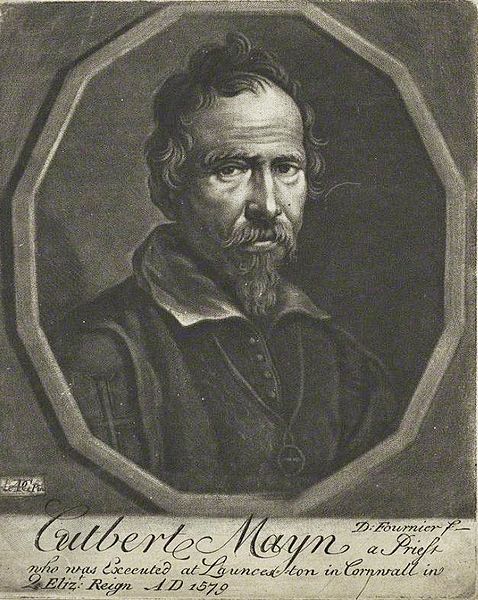St. Cuthbert Mayne
Martyr, born at Yorkston, near Barnstaple, Devonshire (baptized 20 March, 1543-4); died at Launceston, Cornwall, 29 Nov., 1577.
He was the son of William Mayne; his uncle was a schismatical priest, who had him educated at Barnstaple Grammar School, and he was ordained a Protestant minister at the age of eighteen or nineteen. He then went to Oxford, first to St. Alban’s Hall, then to St. John’s College, where he took the degree of M.A. in 1570. He there made the acquaintance of Blessed [now St.] Edmund Campion, Gregory Martin, the controversialist, Humphrey Ely, Henry Shaw, Thomas Bramston, O.S.B., Henry Holland, Jonas Meredith, Roland Russell, and William Wiggs. The above list shows how strong a Catholic leaven was still working at Oxford. Late in 1570 a letter from Gregory Martin to Blessed Cuthbert fell into the Bishop of London’s hands. He at once sent a pursuivant to arrest Cuthbert and others mentioned in the letter. Cuthbert was in the country, and being warned by Blessed Thomas Ford, he evaded arrest by going to Cornwall, whence he arrived at Douai in 1573. Having become reconciled to the Church, he was ordained in 1575; in Feb., 1575-6 he took the degree of S.T.B. at Douai University; and on 24 April, 1576 he left for the English mission in the company of Blessed John Payne. Cuthbert took up his abode with the future confessor, Francis Tregian, of Golden, in St. Probus’s parish, Cornwall. This gentleman suffered imprisonment and loss of possessions for this honour done him by our martyr. At his house our martyr was arrested 8 June, 1577, by the high sheriff, Grenville, who was knighted for the capture. He was brought to trial in September; meanwhile his imprisonment was of the harshest order. His indictment under statutes of 1 and 13 Elizabeth was under five counts: first, that he had obtained from the Roman See a “faculty”, containing absolution of the queen’s subjects; second, that he had published the same at Golden; third, that he had taught the ecclesiastical authority of the pope in Launceston Gaol; fourth, that he had brought into the kingdom an Agnus Dei and had delivered the same to Mr. Tregian; fifth, that he had said Mass.
As to the first and second counts, the martyr showed that the supposed “faculty” was merely a copy printed at Douai of an announcement of the Jubilee of 1575, and that its application having expired with the end of the jubilee, he certainly had not published it either at Golden or elsewhere. As to the third count, he maintained that he had said nothing definite on the subject to the three illiterate witnesses who asserted the contrary. As to the fourth count, he urged that the fact that he was wearing an Agnus Dei at the time of his arrest was no evidence that he had brought it into the kingdom or delivered it to Mr. Tregian. As to the fifth count, he contended that the finding of a Missal, a chalice, and vestments in his room did not prove that he had said Mass.

The Manor House, Golden where St Cuthbert was arrested on June 8, 1577 by Richard Grenville, the Sheriff of Cornwall. Golden Manor was once owned by the Cornishman Francis Tregian the Elder (1548-1608), an Elizabethan recusant, who sheltered the Catholic priest, St. Cuthbert Mayne in his home. The life of Francis Tregian, his host, was spared but he forfeited the manor and spent 26 years in prison refusing to recant his faith. The manor house still has many of its interior Tudor features as well as the original entrance and stone mullion windows seen here. Photo taken by D Gore.
Nevertheless the jury found him guilty of high treason on all counts, and he was sentenced accordingly. His execution was delayed because one of the judges, Jeffries, altered his mind after sentence and sent a report to the Privy Council. They submitted the case to the whole Bench of Judges, which was inclined to Jeffries’s view. Nevertheless, for motives of policy, the Council ordered the execution to proceed. On the night of 27 November his cell was seen by the other prisoners to be full of a strange bright light. The details of his martyrdom must be sought in the works hereinafter cited. It is enough to say that all agree that he was insensible, or almost so, when he was disembowelled. A rough portrait of the martyr still exists; and portions of his skull are in various places, the largest being in the Carmelite Convent, Lanherne, Cornwall.
Camm, Lives of the English Martyrs, II (London, 1905), 204-222, 656; Pollen, Cardinal Allen’s Briefe Historief (London, 1908), 104-110; Cooper in Dict. Nat. Biog., s. v.; Challoner, Memoirs of Missionary Priests, I; Gillow, Bibl. Dict. Eng. Cath., s. v.; Dasent, Acts of the Privy Council (London, 1890-1907), IX, 375, 390; X, 6, 7, 85.
John B. Wainewright (Catholic Encyclopedia)











